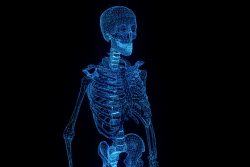
Researchers have isolated human skeletal stem cells from adult and fetal bones that become cartilage, bone or stroma cells. This is the first time that skeletal stem cells have been identified in humans. The team was also able to derive the skeletal stem cells from human induced pluripotent stem cells which opens up the possibility of therapeutic applications.
By identifying this human skeletal stem cell and elucidating its lineage map, the researchers believe molecular diagnosis and treatment of skeletal diseases will occur. There is a tremendous burden imposed by neoplastic, post traumatic, post surgical and degenerative skeletal disorders. Skeletal dysfunction can develop into a broad spectrum of health conditions and despite its significant impact on disease and health, treatments aimed at improving skeletal function are currently limited. A major hurdle is that stem cell regulation in the human skeletal system is largely unexplored.
Bones posses skeletal tissues which have exceptionally regenerative potential. Defects of the bone heal readily and some vertebrates can actually regenerate portions of their limbs. However, regenerative capacities of skeletal tissues in other vertebrates are much more restricted. Bones in humans and mice can recover from small to moderate sized defects. However, adult cartilage tissue possess little to no regenerative ability. Both humans and mice exhibit severe age related degeneration of skeletal tissues with aging.
In the recent study, the team addressed the knowledge gap by identifying and characterizing human skeletal stem cells and downstream cartilage and bone progeny in a variety of tissues. These self renewing and multipotent cells were present in both adult and fetal human bone marrow tissues. They could be derived from iPSCs (induced pluripotent stem cells). By identifying the relationships between downstream skeletal progenitors and human skeletal stem cells, the team was able to create a lineage map of stem cell mediated formation of human skeletal tissues.
Additionally, transcriptomic (the study of the complete set of RNA transcripts that are produced by the genome under specific circumstances or in a specific cell) and epigenetic (the study of changes in organisms caused by modification of gene expression) comparisons with mouse skeletal stem cells revealed evolutionary conserved pathways regulating stem cell mediated formation of skeletal tissues. Divergent molecular pathways which may regulate species specific differences in skeletal structure and bone development were also revealed.
Comparing functional and molecular differences in specific types of stem cells between different species of vertebrates may lead to the uncovering of divergent and convergent mechanisms which underlie tissue growth and regeneration. This understanding could be applied towards enhancing health and rejuvenation in humans.
To view the original scientific study click here: Identification of the Human Skeletal Stem Cell





